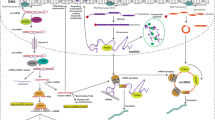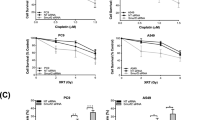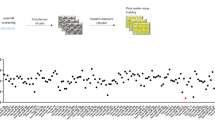Abstract
ABT-737 is a subnanomolar inhibitor of the antiapoptotic proteins Bcl-2, Bcl-XL and Bcl-w. Although ABT-737 triggers extensive cell death in many small-cell lung carcinoma (SCLC) cell lines, some of the SCLC cell lines and the majority of the cancer cell lines derived from other solid tumors were found to be resistant to ABT-737. To better understand the mechanism of resistance to ABT-737, we screened a short interfering RNA library consisting of short interfering RNA against 4000 ‘druggable’ targets in an SCLC-derived cell line, NCI-H196. By comparing the knockdowns with phenotypes, all of the three top ‘hits’ from the screen were found to result from off-target gene silencing. Interestingly, the three off-target siRNAs were found to knock down an antiapoptotic Bcl-2 family protein Mcl-1 owing to the complementation between their seed regions with the 3′ untranslated region (3′ UTR) of Mcl-1. Furthermore, reducing the level of Mcl-1 using siRNAs or the small-molecule compounds Bay43-9006 and Seliciclib was sufficient to overcome the resistance to ABT-737 in the resistant SCLC cell line and cancer cell lines derived from other solid tumors. These results provide further evidence that Mcl-1 is the major factor that causes resistance to ABT-737 in cancer cells derived from diverse solid tumors, and the combination of Mcl-1 downregulating agents with ABT-737 could be potent therapeutic regimens for patient with ABT-737-resistant SCLC and many other types of solid tumors.
This is a preview of subscription content, access via your institution
Access options
Subscribe to this journal
Receive 50 print issues and online access
$259.00 per year
only $5.18 per issue
Buy this article
- Purchase on Springer Link
- Instant access to full article PDF
Prices may be subject to local taxes which are calculated during checkout





Similar content being viewed by others
References
Birmingham A, Anderson EM, Reynolds A, Ilsley-Tyree D, Leake D, Fedorov Y et al. (2006). 3′ UTR seed matches, but not overall identity, are associated with RNAi off-targets. Nat Methods 3: 199–204.
Danial NN, Korsmeyer SJ . (2004). Cell death: critical control points. Cell 116: 205–219.
Fire A, Xu S, Montgomery MK, Kostas SA, Driver SE, Mello CC . (1998). Potent and specific genetic interference by double-stranded RNA in Caenorhabditis elegans. Nature 391: 806–811.
Jackson AL, Bartz SR, Schelter J, Kobayashi SV, Burchard J, Mao M et al. (2003). Expression profiling reveals off-target gene regulation by RNAi. Nat Biotechnol 21: 635–637.
Kirkin V, Joos S, Zornig M . (2004). The role of Bcl-2 family members in tumorigenesis. Biochim Biophys Acta 1644: 229–249.
Kitada S, Zapata JM, Andreeff M, Reed JC . (2000). Protein kinase inhibitors flavopiridol and 7-hydroxy-staurosporine down-regulate antiapoptosis proteins in B-cell chronic lymphocytic leukemia. Blood 96: 393–397.
Lin X, Ruan X, Anderson MG, McDowell JA, Kroeger PE, Fesik SW et al. (2005). siRNA-mediated off-target gene silencing triggered by a 7 nt complementation. Nucleic Acids Res 33: 4527–4535.
Oltersdorf T, Elmore SW, Shoemaker AR, Armstrong RC, Augeri DJ, Belli BA et al. (2005). An inhibitor of Bcl-2 family proteins induces regression of solid tumours. Nature 435: 677–681.
Saxena S, Jonsson ZO, Dutta A . (2003). Small RNAs with imperfect match to endogenous mRNA repress translation. Implications for off-target activity of small inhibitory RNA in mammalian cells. J Biol Chem 278: 44312–44319.
Tijsterman M, Ketting RF, Plasterk RH . (2002). The genetics of RNA silencing. Annu Rev Genet 36: 489–519.
van de Donk NW, Kamphuis MM, van Kessel B, Lokhorst HM, Bloem AC . (2003). Inhibition of protein geranylgeranylation induces apoptosis in myeloma plasma cells by reducing Mcl-1 protein levels. Blood 102: 3354–3362.
Waterhouse PM, Wang MB, Lough T . (2001). Gene silencing as an adaptive defence against viruses. Nature 411: 834–842.
Yu C, Bruzek LM, Meng XW, Gores GJ, Carter CA, Kaufmann SH et al. (2005). The role of Mcl-1 downregulation in the proapoptotic activity of the multikinase inhibitor BAY 43-9006. Oncogene 24: 6861–6869.
Zeng Y, Yi R, Cullen BR . (2003). MicroRNAs and small interfering RNAs can inhibit mRNA expression by similar mechanisms. Proc Natl Acad Sci USA 100: 9779–9784.
Author information
Authors and Affiliations
Corresponding author
Rights and permissions
About this article
Cite this article
Lin, X., Morgan-Lappe, S., Huang, X. et al. ‘Seed’ analysis of off-target siRNAs reveals an essential role of Mcl-1 in resistance to the small-molecule Bcl-2/Bcl-XL inhibitor ABT-737. Oncogene 26, 3972–3979 (2007). https://doi.org/10.1038/sj.onc.1210166
Received:
Revised:
Accepted:
Published:
Issue Date:
DOI: https://doi.org/10.1038/sj.onc.1210166
Keywords
This article is cited by
-
BH3-only proteins are dispensable for apoptosis induced by pharmacological inhibition of both MCL-1 and BCL-XL
Cell Death & Differentiation (2019)
-
BIM mediates synergistic killing of B-cell acute lymphoblastic leukemia cells by BCL-2 and MEK inhibitors
Cell Death & Disease (2016)
-
Functional kinomics establishes a critical node of volume-sensitive cation-Cl− cotransporter regulation in the mammalian brain
Scientific Reports (2016)
-
Antihelminthic benzimidazoles potentiate navitoclax (ABT-263) activity by inducing Noxa-dependent apoptosis in non-small cell lung cancer (NSCLC) cell lines
Cancer Cell International (2015)
-
gespeR: a statistical model for deconvoluting off-target-confounded RNA interference screens
Genome Biology (2015)



